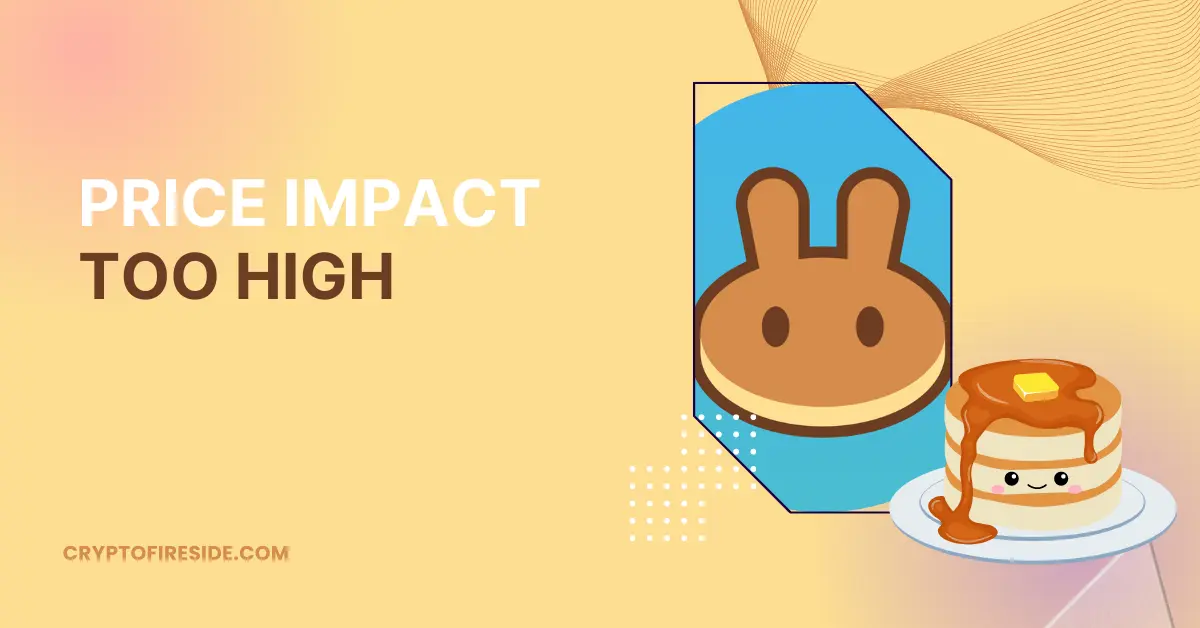Price Impact Too High PancakeSwap Error- Find Out How To Fix It Easily
Let's explore what this message means, if it is still a problem in 2022 and how to fix it.

TL:DR Want to skip all the mumbo-jumbo below and just get the solution? OK, here it is. For errors or messages saying Price Impact Too High on PancakeSwap: Trade a smaller amount, or increase the slippage tolerance via the settings icon and try again. This is caused by low liquidity.
It's as simple as that.
There are dozens of websites and forums giving long-winded explanations and workarounds. Some of them, are, in fact, completely wrong and give terrible advice. Still, the reality is that this error has a simple fix and we just provided the solution above.
If you want to understand why this Price Impact Too High PancakeSwap issue comes up in the first place and why we suggest the solution we do, keep reading.
To Understand the “Price Impact Too High” Issue, We First Need to Know What PancakeSwap Is And How It Works
To answer the bigger question first let's explore what PancakeSwap is and how it works as it is critical to understanding the Price Impact Too High PancakeSwap problem.
As you probably already know, if you are using the PancakeSwap exchange, and for those that don't, PancakeSwap is a decentralized exchange (DEX) built for the Binance Smart Chain. It is also known as a "Swap" exchange which is where it gets its name from.
All decentralized swap exchanges in the world of cryptocurrency and DeFi need a few things to operate:
- The exchange itself. The domain name and a website or app for its users.
- Automated market-maker technology.
- Liquidity pools.
- Liquidity.
- Tokens.
- Liquidity providers.
The Exchange
PancakeSwap is a decentralized swap exchange, that means that the central authority, in this case, PancakeSwap is not providing liquidity or doing the market making, as a normal centralized market-making exchange would.
All PancakeSwap does is provide or facilitate a market. It's kind of like a swap-meet for the old-school computer hardware geeks out there or a flea market. PancakeSwap sets up the place where the action happens, it could be a car park or a basketball hall, and then it attracts people who bring their coins and swap them.
OK, so PancakeSwap has a a website and app that acts as a marketplace of sorts but how does it all work?
Automated Market Maker Technology
You can think of AMM technology as a program or calculator that uses a mathematical formula to give you a price based on two assets.
Normally in the centralized world, this is done by someone called a marketmaker. They take the buy and sell orders, take their cut, and come up with the market price.
The mathematical formula may differ slightly from DEX to DEX but usually it looks something like this: X * Y = K. This means X is the amount of one token in the liquidity pool, Y is the amount of the other token in the pool and K is the fixed total of both tokens. There has to be a fixed amount otherwise trades wouldn't be able to happen correctly.
Automated market maker technology is an algorithm that PancakeSwap and other swap exchanges use as part of their decentralized solution because when you are swapping on their exchange you are not swapping with another person or trader, AKA a counterparty, you are swapping via a smart counteract and swapping with the liquidity pool.
Liquidity Pools
So if PancakeSwap is not providing liquidity, who does? Liquidity providers do. They "pool" their tokens so that there is a larger amount because one trader alone may not be able to provide the number of tokens that another trader wants to buy. And this is one of the reasons why PancakeSwap uses this method as do many other popular decentralized exchanges like UniSwap.
An analogy below:
I run a supermarket. I have plenty of oranges but I have no apples. I need apples so that I can sell them to my customer. There is no single farmer who has enough apples because I need about 1300 apples. There are three farmers that have apples.
Farmer A has 100 apples, farmer B has 200 apples and farmer C has 1000 apples. If the farmers pool their apples together, I can swap them for my 1000 oranges because oranges are worth slightly more than apples.
I deliver my oranges to an automated robotic machine, it takes my oranges, counts my oranges, asks me to provide 3 more oranges as a fee, and gives me 1300 apples in exchange. The pool gets the oranges back which the farmers can take their share of at any time and the farmers also all get 1 additional orange as a reward for providing apples to the pool.
Liquidity
This is the lifeblood of all decentralized swap exchanges.
Let's take a look at what PancakeSwap has to say about "Liquidity":
"Liquidity" is central to how PancakeSwap's Exchange works. You can add liquidity for any token pair by staking both through the Liquidity page. In return for adding liquidity, you'll receive trading fees for that pair, and receive LP Tokens you can stake in Farms to earn CAKE rewards!
Read that back, "Liquidity" is central to how PancakeSwap's Exchange works. If there is no liquidity, there is no PancakeSwap or at least there is no market for the particular tokens to be swapped. That's just how it works.
In order for their to be a liquidity pool, there needs to be liquidity, in order for there to be liquidity there needs to be enough of both tokens and a provider willing to provide that token to a pool.
Tokens
We all know what tokens are. Synonymous words are crypto, cryptocurrency, coins and so on. While there are differences, which we won't get into right here and now, it is suffice to say that in order for pools to function, tokens need to exist, and enough of them need to be in a healthy circulation meaning, distributed among many holders because if they were just distributed amongst a small handful of holders that might mean that these holders don't want to pool their tokens and provide liquidity.
In order for their to be enough tokens, they need to be mined, minted, and distributed through various different options and eventually be circulated around to many holders as mentioned above.
This is not a problem for most large cryptocurrencies. Take PancakeSwaps, BEP20 native CAKE token, it has a circulating supply of 145,336,092.60 CAKE with 1,237,722 addresses AKA holders. This almost guarantees that enough people will want to provide some of their tokens for liquidity because don't forget, they are being incentivized with fees as a reward.
This is sometimes a problem though for newer projects with newer tokens. Some new tokens either have their supply limited on purpose on there are simply not enough circulating or not enough holders. These sorts of things can create problems when thinking about liquidity.
Liquidity Providers
It does not matter if there are thousands of people willing or wanting to swap their tokens because unless those tokens are added to PancakeSwap liquidity pools nothing will happen. There cannot be a sustainable market.
These special little individuals are called liquidity providers. The liquidity provider holds a particular type of token and decides he or she wants to provide liquidity and in return, they receive a transaction fee as a reward for providing liquidity.
These special little individuals also take on risks. As we all know where there is a risk, there is usually a reward. We have covered the reward side. Let's quickly cover something called impermanent loss which is the risk that the liquidity provider takes.
Impermanent loss means that if the price of the token which has been deposited into a liquidity pool changes and goes down, that is the impermanent loss. Looking back at our farmer and apple analogy, if the price of apples goes down after they pooled their apples they will still get their reward but their apples are not worth as much now, fewer oranges can now buy more apples in this example and so the liquidity providers are left with a loss.
Now We Have All the Pieces Together to Answer the Price Impact Too High PancakeSwap Problem
You now understand what PancakeSwap is, how automated markets work, how liquidity pools work, what liquidity providers are, and what liquidity is when thinking about tokens.
In summary and to understand the problem better, all PancakeSwap does is that they build a platform and incentivize people to provide liquidity and in return, those people receive a fee from the trading or swapping of those tokens.
This Is the Crux of the Issue
If there is not enough liquidity the price impact too high PancakeSwap warning comes up.
In simple terms, this is a supply v demand issue just like it is in any other market. It just means there are not enough people providing enough liquidity in this market and so the price could be affected.
Where does this issue stem from?
PancakeSwap V1 versus PancakeSwap V2
PancakeSwap upgraded to Version 2 in April 2021. As part of this upgrade liquidity providers naturally pulled their assets from Version 1 and moved them to Version 2 of the exchange.
With this, the warning was appearing far more frequently for traders while the platform and its liquidity providers were switching to the newer version of PancakeSwap.
This warning is not solely related to the upgrade from V1 to V2. The upgrade just exacerbated it and made it so that many more people were seeing it.
Some websites and forums are still incorrectly telling readers and viewers that a solution to this problem is to switch back to Version 1. This is not correct and dangerous! This should only be advised if the user understands the following:
While PancakeSwap V1 is still accessible it is no longer supported which means, that if there was an issue with the platform, you will potentially be stuck in a type of no man's land and assume that as time continues to go on, less and less liquidity will be provided to V1 and more will continue to be provided to V2.
In fact, currently, as it stands V2 has a trading volume of $192 million and V1 only has a trading volume of $849 thousand.
Only use V1 if you are absolutely clear and aware of what you are doing and you feel comfortable with any risks involved.
The better solution is to make a slight change to the slippage tolerance or trade smaller amounts over time using V2. In fact, this is the exact advice provided by PancakeSwap too!:
Price Impact too High
Try trading a smaller amount, or increase slippage tolerance via the settings icon and try again. This is caused by low liquidity.
Because this problem likely does not occur with major tokens and instead is experienced with smaller token projects, alternatively, another practical solution is to contact the developers or community teams of those projects and enquire with them as to why there is no liquidity in V2.
We hope this troubleshooting guide has helped you understand the PancakeSwap price impact too high error and has shown you how to get around it if it is still a problem.
If you enjoyed this article, please share it.
Want to know how you can support Crypto Fireside?
Sign up below. It's free and easy 🔥.

